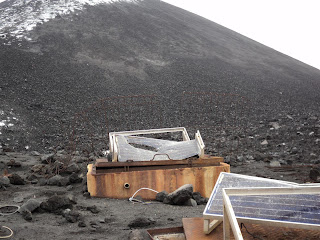Heading to the island immediately east of Java is probably the most popular getaway from town but I'd like to offer a trip westward to Sumatra as my constructive suggestion of the week. Last weekend I hit the Jakarta - Merak toll road and steamed to the ferry port at full speed (although I was occasionally held up by lumbering juggernauts that couldn’t seem to top a brisk walking speed).
At Merak, I drove onto one of the ferries that leave every half an hour, 24 hours a day and strolled up onto the deck to take the air. This was at night alas, however my return ferry from Bakauheni to Merak at seven in the morning sailed out of a very picturesque harbour past several outlying islands as the sun beat down on me on my deck chair with my knotted handkerchief on my head.
Most Indonesians prefer to stay out of the sun in the ship’s foetid, rusting bowels however, consuming their own bodyweights in peanuts and watching karaoke DVDs in the so-called, "lounge", and seeing as they were mainly swarthy, piss taking, truck driving types, this suited me just fine.
Anyway, back to the outward journey, half an hour from Bakauheni, you’ll find the sleepy seaside town of Kalianda, which sports some lovely deserted white sand beaches and a nearby mountain, the 1000m plus peak of Gunung Rajabasa. Generally, it's a pleasant, typical Indonesian seaside town and indicative of how the mandarins in charge of tourism here should be thinking outside the box in their efforts to get people to places like this. Mind you, this presupposes the ability to think inside the box, which is a big assumption admittedly.
I was on a different mission however and headed to the colourful flotilla of fishing vessels at the small harbour on the outskirts of town in order to rent a boat to take me to Indonesia's most famous volcanic peak, the legendary Krakatau. I soon boarded a mini fishing launch with a sewing machine for an outboard motor and we started chugging out over the waves. We stopped briefly at Pulau Sebesi, one of the numerous islands on the four and a half hour voyage to Krakatau and then continued on.
A huge storm blew up and drenched us after half an hour. Water also got into the engine, causing it to grind to a halt until the downpour eased. So there I was, sitting in a glorified canoe drifting miles from anywhere with the rain beating down on me. A precious moment indeed.
Eventually, we arrived on the black sands of Anak Krakatau (Child of Krakatau), the junior volcano that eventually emerged from the depths of the ocean in 1927 after the original beast had exploded into a billion pieces in 1883. The 1883 eruption created a tsunami that killed 30,000 people, sent out a shock wave that circled the Earth seven times and has now passed into global folklore of course.
The island’s security guard, a wizened old soul who looked as if he’d arrived on the scene around the time of the 1883 eruption, informed me that it's perfectly okay to camp on the beaches when the volcano is not active. When it is active however, the beach of a neighbouring island, about 700m away, fills with hippies and TV reporters who watch the light show all night long.
The thick jungle that fringes the picturesque beaches of Anak Krakatau only extends back about 100m before petering out into the ashen slopes of the still smouldering volcano. We climbed up to the last reachable point, about 50m below the ominous, smoking, sulphurous summit and enjoyed the quite breathtaking views of both the volcano itself and the surrounding oceans and islands.
I notice a smashed seismograph near to where I stood. It was a twisted heap of rusting metal and broken glass with a huge volcano ejected boulder lying slap bang in the middle of it. I guess that this shattered device, along with the recent Europe wide volcano air travel debacle, could be said to symbolise how mankind, for all his industry, technology and vitamin enriched, quadcore hubris, is still at the mercy of the larger forces of nature.
In fact, I recently became aware of a fascinating theory that links the fate of our species very closely with volcanic activity. The 1883 Krakatau eruption, huge as it was, was ultimately peanuts in comparison with some of the mega volcano super eruptions that have occurred throughout geological history. The most recent of these super eruptions spewed forth from the massive volcano crater that now holds the enormous Lake Toba in Sumatra around 70,000 years ago.
This eruption is described by scientists as being, "Mega colossal," and is thought to have caused a decade-long volcanic winter, as well as a 1000 year long, "Cooling episode," over the entire planet. By coincidence, geneticists have discovered that our species, already flourishing at this point, hit a, "Population bottleneck," around (drum roll please) 70,000 years ago.
The theory is that the Toba eruption proved so utterly catastrophic to the environment that humanity was reduced to maybe a couple of thousand people before the population re-expanded many years later. DNA evidence shows that we are all much more closely related to each other that we should be, given the age of our species.
So there you have it. We really are all brothers and sisters, and it's all thanks to Indonesia!
















